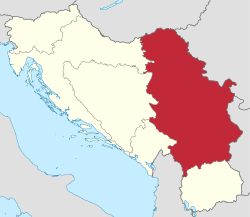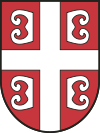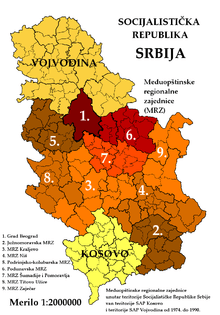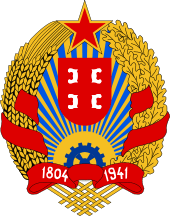Socialist Republic of Serbia
| Federal State of Serbia Федерална Држава Србија Federalna Država Srbija (1945–1946) People's Republic of Serbia Народна Република Србија Narodna Republika Srbija (1946–1963) Socialist Republic of Serbia Социјалистичка Република Србија Socijalistička Republika Srbija (1963–1990) Republic of Serbia Република Србија Republika Srbija (1990–1992) | ||||||
| Constituent republic of Yugoslavia | ||||||
| ||||||
| ||||||
 | ||||||
| Capital | Belgrade | |||||
| Government | Marxist–Leninist one-party socialist republic (1945–48) Titoist one-party socialist republic (1948–90) Parliamentary republic (1990-1992) | |||||
| President | ||||||
| • | 1945-1953 | Siniša Stanković(first) | ||||
| • | 1989-1992 | Slobodan Milošević(last) | ||||
| Legislature | National Assembly | |||||
| Historical era | Cold War, World War II | |||||
| • | ASNOS | 9–12 November 1945 | ||||
| • | End of World War II | 8 May 1945 | ||||
| • | Last Constitution adopted | 28 September 1990 | ||||
| • | Federal Republic of Yugoslavia declared | 27 April 1992 | ||||
| Area | ||||||
| • | 1991 | 88,361 km2 (34,116 sq mi) | ||||
| Population | ||||||
| • | 1991 | 9,506,174 | ||||
| Density | 107.6 /km2 (278.6 /sq mi) | |||||
| ||||||
The Socialist Republic of Serbia (Serbian: Социјалистичка Република Србија / Socijalistička Republika Srbija) was one of the six constitutional republics of the Socialist Federal Republic of Yugoslavia. It was the largest republic in terms of population and territory. Its capital, Belgrade, was also the federal capital of Yugoslavia.
History
Part of a series on the |
||||||||||||||||
|---|---|---|---|---|---|---|---|---|---|---|---|---|---|---|---|---|
| History of Serbia | ||||||||||||||||
 | ||||||||||||||||
|
||||||||||||||||
|
||||||||||||||||
|
||||||||||||||||
|
||||||||||||||||
|
||||||||||||||||
|
| ||||||||||||||||
In April 1945 ASNOS officialy created Federal State of Serbia (Serbian: Федерална Држава Србија / Federalna Država Srbija. In January 1946, after bringing first constitution of Socialist Yugoslavia, Federal State of Serbia was renamed to Peoples's Republic of Serbia (Народна Република Србија / Narodna Republika Srbija).
From 1946 to 1963, the republic was officially known as People's Republic of Serbia, and from 1963 to 1990 as Socialist Republic of Serbia (Социјалистичка Република Србија / Socijalistička Republika Srbija). The republic had two provinces, Vojvodina and Kosovo.
For most of its existence in the SFRY, Serbia was loyal and generally subordinate to the federal government. This changed after the death of Josip Broz Tito in 1980, when there was a rise in Albanian as well as Serbian nationalism in Kosovo. The League of Communists was split on how to respond. A successful round of coups in the Communist party leadership of Serbia as well as Montenegro occurred from 1988 to 1989, led by Slobodan Milošević; he supported Serbian nationalists in Kosovo to end the state's autonomy.
In 1989, Milošević was elected as President of the republic. He demanded that the federal Yugoslav government act for the interests of Serbia in Kosovo by sending in the Yugoslav People's Army to take control of the province. Serbia opposed such action and demanded a "one-member, one-vote" system in the Yugoslav League of Communists, which would have given a majority of votes to Serbs. Ethnic tensions increased and the League of Communists of Yugoslavia collapsed, followed by the fall of the government of Yugoslavia by 1991.
After 1990, the state was known simply as Republic of Serbia (Република Србија / Republika Srbija). In 1992, when the Federal Republic of Yugoslavia was formed, Serbia became one of its two constituent republics. In 2003 this state union was re-formed into Serbia and Montenegro, and in 2006 Serbia became an independent state after Montenegro separated.


Administrative divisions

Within Socialist Republic of Serbia two autonomous provinces existed: Socialist Autonomous Province of Vojvodina and Socialist Autonomous Province of Kosovo. The central part of the Socialist Republic of Serbia located outside of the two autonomous provinces was generally known as "Serbia proper" ("Uža Srbija").
Geographically SR Serbia bordered Hungary to the north, Romania and Bulgaria to the east and Albania to the south-west. Within Yugoslavia it bordered SR Macedonia to the south and SR Montenegro, Bosnia and Herzegovina and Croatia to the west.
Demographics
1971 census
In 1971, total population of the Socialist Republic of Serbia numbered 8,446,591 people, including:
- Serbs = 6,142,071 (72.71%)
- Albanians = 984,761 (11.66%)
- Hungarians = 430,314 (5.10%)
- Croats = 184,913 (2.19%)
- Muslims = 154,330 (1.83%)
- Yugoslavs = 123,824 (1.47%)
- Slovaks = 76,733 (0.82%)
- Romanians = 57,419 (0.62%)
- Bulgarians = 53,800 (0.58%)
- Romani = 49,894 (0.54%)
- Macedonians = 42,675 (0.46%)
- Rusyns = 20,608 (0.22%)
- Turks = 18,220 (0.20%)
- Slovenes = 15,957 (0.17%)
- Vlachs = 14,724 (0.16%)
1981 census
In 1981, total population of the Socialist Republic of Serbia numbered 9,313,677 people, including:
- Serbs = 6,331,527 (67.96%)
- Albanians = 1,303,032 (13.99%)
- Yugoslavs = 441,941 (4.75%)
- Hungarians = 390,468 (4.19%)
- Muslims = 215,166 (2.31%)
- Croats = 149,368 (1.60%)
- Romani = 110,956 (1.19%)
- Macedonians = 48,986 (0.53%)
- Slovenes = 12,006 (0.13%)
Politics
In the Socialist Republic, the only legal political party was the League of Communists of Serbia (SKS), which was part of the League of Communists of Yugoslavia (SKJ). The party remained relatively stable and loyal to the federal party until the late 1980s, when the party became split over what action to take in Kosovo when protests and fights broke out between ethnic Albanians and Serbs.
The more traditional Communists supported President Ivan Stambolic, who advocated continued neutrality as a means to solve the dispute; while more radical and nationalist-leaning members supported Slobodan Milosevic, who advocated the protection of Kosovo Serbs, who had claimed that their population was being pressured to leave Kosovo by Albanian separatists. Milosevic utilized public sentiment and opposition to Kosovo Albanian separatism to rally large numbers of supporters to help him overthrow the Communist leadership in Vojvodina, Kosovo and the Socialist Republic of Montenegro in what was known as the anti-bureaucratic revolution. Afterwards, the Serbian League of Communists selected Milosevic as its leader. Milosevic took a hard stand on Albanian nationalism in Kosovo and pressured the Yugoslav government to give him emergency powers to deal with Kosovo Albanian separatists. Furthermore, he reduced the autonomy of the autonomous provinces of Kosovo and Vojvodina and installed politicians loyal to him to serve as their representatives.
In the congress of the Yugoslav League of Communists in 1990, Milosevic and his subordinate representatives for Vojvodina, Kosovo and the Socialist Republic of Montenegro attempted to silence opposition from the Socialist Republic of Slovenia who opposed the actions taken against Kosovo Albanian leadership, by blocking all reforms proposed by the Slovene representatives. The tactic failed and Slovenia, along with its ally Croatia, abdicated from the Yugoslav Communist Party. This caused the Yugoslav Communist party to fall apart, and then the state of Yugoslavia itself one year later.
Heads of institutions
Chairman of ASNOS (1944 - 1945)
- Siniša Stanković (12 November 1944 - 7 April 1945)
Presidents
- President of the Presidium of the People's Assembly (1945 - 1953)
- Siniša Stanković (7 April 1945 - March 1953)
- Presidents of the National Assembly (1953 - 1974)
- Petar Stambolić (December 1953 - April 1957)
- Jovan Veselinov (April 1957 - 26 June 1963)
- Dušan Petrović (26 June 1963 - 6 May 1967)
- Miloš Minić (6 May 1967 - 6 May 1969)
- Dragoslav Marković (6 May 1969 - 19 April 1974)
- Živan Vasiljević (19 April - 6 May 1974)
- Presidents of the Presidency (1974 - 1990)
- Dragoslav Marković (6 May 1974 - 5 May 1978)
- Dobrivoje Vidić (5 May 1978 - 5 May 1982)
- Nikola Ljubičić (5 May 1982 - 5 May 1984)
- Dušan Čkrebić (5 May 1984 - 5 May 1986)
- Ivan Stambolić (5 May 1986 - 14 December 1987)
- Petar Gračanin (14 December 1987 - 20 March 1989)
- Ljubiša Igić (20 March - 8 May 1989) (acting)
- Slobodan Milošević (8 May 1989 - 28 September 1990)
Prime Ministers
- Minister for Serbia in Yugoslav government
- Jaša Prodanović (7 March 1945 - 9 April 1945)
- President of the Government
- Blagoje Nešković (9 April 1945 - 5 September 1948)
- Petar Stambolić (5 September 1948 - 5 February 1953)
- President of the Executive Council
- Petar Stambolić (5 February 1953 - 16 December 1953)
- Jovan Veselinov (16 December 1953 - 6 April 1957)
- Miloš Minić (6 April 1957 - 9 June 1962)
- Slobodan Penezić Krcun (9 June 1962 - 6 November 1964)
- Stevan Doronjski (Acting; 6 November 1964 - 17 November 1964)
- Dragi Stamenković (17 November 1964 - 6 June 1967)
- Đurica Jojkić (6 June 1967 - 7 May 1969)
- Milenko Bojanić (7 May 1969 - 6 May 1974)
- Dušan Čkrebić (6 May 1974 - 6 May 1978)
- Ivan Stambolić (6 May 1978 - 5 May 1982)
- Branislav Ikonić (5 May 1982 - 6 May 1986)
- Desimir Jevtić (6 May 1986 - 5 December 1989)
- Stanko Radmilović (5 December 1989 - 28 September 1990)
See also
Sources
- Bataković, Dušan T., ed. (2005). Histoire du peuple serbe [History of the Serbian People] (in French). Lausanne: L’Age d’Homme.
External links

.svg.png)
